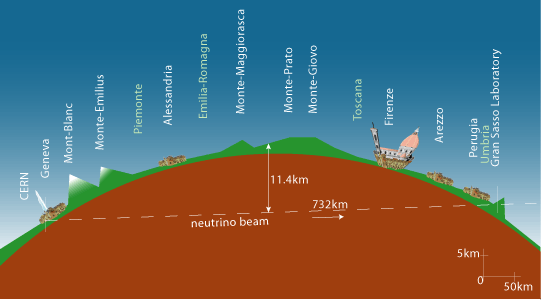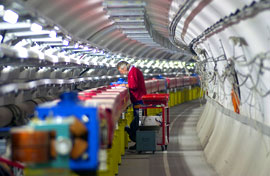Related links
- CNGS project
- Gran Sasso laboratory
- OPERA experiment
- ICARUS experiment
This website is no longer maintained. Its content may be obsolete. Please visit http://home.cern for current CERN information.
This summer, CERN gave the starting signal for the long-distance neutrino race to Italy. The CNGS facility (CERN Neutrinos to Gran Sasso), embedded in the laboratory's accelerator complex, produced its first neutrino beam. For the first time, billions of neutrinos were sent through the Earth's crust to the Gran Sasso laboratory, 732 kilometres away in Italy, a journey at almost the speed of light which they completed in less than 2.5 milliseconds. The OPERA experiment at the Gran Sasso laboratory was then commissioned, recording the first neutrino tracks.

The CNGS project is expected to unravel some of the mysteries surrounding neutrinos. Neutrinos, which are very light, neutral particles, interact very little with matter. They fill the Universe but are virtually impossible to capture. 400 billion neutrinos pass through us every second and yet only one or two will ever interact with our bodies throughout our entire lives. The fact that they are extremely hard to intercept goes some way to explaining the mystery that surrounds them.
We know that there are three types – or flavours – of neutrino: the electron neutrino, the muon neutrino and the tau neutrino. But physicists want to find out why the flux of neutrinos from the sun is much smaller than theory predicts. This deficit may be due to the transformation (or oscillation) of neutrinos from one flavour into another, a process which has been observed in recent experiments. This phenomenon, known as oscillation, is directly linked to another fundamental question that torments physicists, that of the neutrino mass. Oscillation has shown that neutrinos have a mass, but it has yet to be determined. The mass of neutrinos is crucial. Even if they are infinitesimally light, these particles could contribute to the Universe’s mysterious dark matter, which is invisible to telescopes but whose gravitational effect can be observed. A better knowledge of neutrino mass would also allow physicists to complete the puzzle that is the theory of the fundamental forces of nature and would help them to understand why matter is more prevalent in our Universe than antimatter.
The CNGS project is to provide evidence of neutrino oscillation which is thought to occur over long distances. To achieve this, OPERA, a first experiment nestling below 1440 metres of rock, has been commissioned at the Gran Sasso laboratory. OPERA’s huge detector, weighing 1800 tonnes, should identify particles transformed from muon neutrinos into tau neutrinos during the journey, thus demonstrating oscillation. OPERA is expected to intercept and detect around 25 muon neutrinos out of the one hundred billion that will reach it every day. Around fifteen tau neutrinos produced by oscillation are expected to be detected over five years. A second experiment, ICARUS, is expected to be built in the coming years.
 The production of a high-intensity neutrino beam at CERN requires a complex facility. A proton beam produced and accelerated by the CERN accelerators is directed onto a graphite target to give birth to other particles called pions and kaons. These particles are then fed into a system comprising two magnetic horns which focus them into a parallel beam that is directed towards Gran Sasso. Next, in a 1000 metre-long tunnel, the pions and kaons decay into muons and muon neutrinos. At the end of this decay tunnel, an 18 metre thick block of graphite and metal absorbs the protons, pions and kaons that did not decay. The muons are stopped by the rock. Impervious to all such obstacles, the muon neutrinos will leave the CERN tunnels and streak through the rock on their 732 kilometre journey to Italy.
The production of a high-intensity neutrino beam at CERN requires a complex facility. A proton beam produced and accelerated by the CERN accelerators is directed onto a graphite target to give birth to other particles called pions and kaons. These particles are then fed into a system comprising two magnetic horns which focus them into a parallel beam that is directed towards Gran Sasso. Next, in a 1000 metre-long tunnel, the pions and kaons decay into muons and muon neutrinos. At the end of this decay tunnel, an 18 metre thick block of graphite and metal absorbs the protons, pions and kaons that did not decay. The muons are stopped by the rock. Impervious to all such obstacles, the muon neutrinos will leave the CERN tunnels and streak through the rock on their 732 kilometre journey to Italy.
September 2006